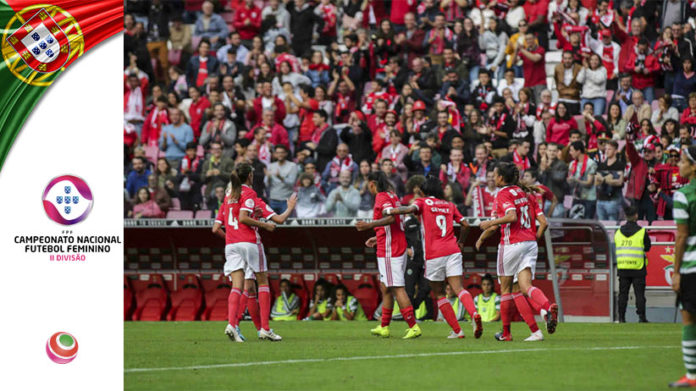La tipica frase “il calcio non è per le donne!” ha perso sempre più forza, e il Portogallo ne è un esempio. Attualmente, e secondo i dati della Federcalcio portoghese (FPF), ci sono più di 11mila giocatrici di calcio (6652) e futsal (4386) ma questo non è mai stata l’abitudine.
È stato nel 2016 che il calcio femminile ha fatto un balzo in avanti, quando la FPF ha preso la coraggiosa decisione di invitare le 18 squadre nel principale campionato di calcio maschile a creare una propria squadra femminile. I primi 4 club ad accogliere tale proposta avrebbero avuto accesso diretto alla massima serie, all’epoca denominata Campeonato Nacional Allianz. Sporting Clube de Portugal (SCP), Sporting de Braga, Belenenses ed Estoril Praia, che già avevano squadre femminili che gareggiavano nella seconda serie di calcio femminile, hanno accettato l’invito.
SCP ha iniziato forte e ha scommesso tutte le proprie chips in allenamento, dando opportunità e rafforzando le proprie giocatrici già in squadra e richiamando le giocatrici che erano all’estero, come Ana Borges dal Chelsea con l’obiettivo di aggiungere esperienza ed aiutare le giovani. La strategia ha funzionato e gli è valso il Campionato proprio nella stagione d’esordio, così come la Taça de Portugal, la coppa nazionale. Hanno fatto il bis la stagione successiva ed hanno vinto di nuovo il trofeo interno.
A sua volta, il Braga ha cercato forze all’estero, pensando che le atlete portoghesi della loro squadra avessero bisogno di un aiuto esterno. Nella stagione 2018-2019, il loro lavoro ed il loro impegno gli hanno fatto conquistare lo scudetto.
Quello che è certo è che fino alla fine c’è stata competizione, sensazionalismo ed emozione. Un anno dopo la proposta della FPF è stata fatta la storia e il record di presenze di oltre 12mila spettatori è stato stabilito nella finale di Taça de Portugal, tra SCP e Sporting de Braga. Questo ha mostrato crescita, interesse e visibilità.
Nel 2018, Sport Lisboa e Benfica (SLB), entrano in scena e scommettono insieme nel calcio femminile. Hanno iniziato nella Serie B ed i numeri sono stati travolgenti: 27 vittorie, 1 pareggio, 365 gol segnati ed uno concesso. Questo è valso loro la promozione nella prima serie (Liga BPI). I risultati hanno messo in luce le differenze tra il primo ed il secondo livello del campionato. Ma anche tra le giocatrici professioniste e dilettanti, quindi c’era ancora del lavoro da fare.
La Federcalcio portoghese ha annunciato l’aumento del numero delle squadre partecipanti alla Liga BPI. Da 12 a 20 squadre nella prossima stagione (2020/2021). Ciò è dovuto all’impatto di COVID-19. Questa è stata la strada che la FPF ha concordato per supportare lo sviluppo e la crescita delle giocatrici, molte delle quali giocano per la nazionale, nei vari campionati.
Ma il calcio femminile in Portogallo non è fatto solo di giocatrici e squadre di qualità. Ci sono anche allenatori qualificati e una vera scommessa negli arbitri donna. Questi fattori hanno contribuito a dare impulso al Portogallo nel campo nazionale e internazionale del calcio femminile.
Attualmente, ci sono molti giocatrici famose in Portogallo, che portano una qualità superiore al campionato nazionale e di conseguenza alle giocatrici portoghesi. Ci sono anche molte atlete portoghesi che giocano in grandi squadre europee, come Jéssica Silva all’Olympique Lyonnais, Matilde Fidalgo al Manchester City (ora al Benfica) e Mónica Mendes che ha indossato i colori del Milan per poi trasferirsi allo Sporting Lisbona nell’ultima sessione di calciomercato.
Migliorando le infrastrutture, i campionati e favorendo la crescita, le scommesse delle squadre hanno dato i loro frutti. Il fatto che le giocatrici portoghesi stiano giocando a livello internazionale, un qualcosa di impossibile fino a pochi anni fa, si riflette poi sulla Nazionale e sui risultati che ha raggiunto.
_______________________________________________________________________
The typical phrase “football is not for women!” has been losing more and more strength, and Portugal is an example of this. Currently, and according to data from the Portuguese Football Federation (FPF), there are more than 11 thousand football (6652) and futsal (4386) athletes. But this was not always the case.
It was in 2016 that women’s football took a leap, when the FPF made the bold decision to invite the 18 teams of the main men’s football league to start women’s teams. The first 4 would have direct access to the First League, called Campeonato Nacional Allianz at the time. Sporting Clube de Portugal (SCP), Sporting de Braga, Belenenses and Estoril Praia, who already had women’s teams competing in second league of women’s football, accepted the invitation.
SCP started strong and bet all their chips in training, giving opportunities to and strengthening their existing players, and calling back players who were abroad, like Ana Borges from Chelsea with the aim of adding experience and helping the younger ones. The strategy worked and earned them the Championship right in the debut season, as well as the Taça de Portugal. They did an encore the following season and won the two competitions again.
In turn, Braga looked for strength abroad, thinking that the Portuguese athletes from their team needed outside help. In the 2018-2019 season, their work, effort, and commitment earned them the Championship.
What is certain is that there was competition, sensationalism, and emotion until the end. A year after the FPF’s proposal, in 2017, history was made and the attendance record of more than 12 thousand spectators was set in the final of Taça de Portugal, between SCP and Sporting de Braga. This showed growth, interest, and visibility.
In 2018, Sport Lisboa e Benfica (SLB), enters the scene and takes a gamble on women’s football. They started in the second league and the numbers were overwhelming (27 wins, 1 draw, 365 goals scored and one conceded). This earned them the promotion to the first league (Liga BPI).
The results brought out the differences between the first and second leagues, but also between the professional and amateur players, so there was still work to be done.
The Portuguese Football Federation announced the first league of Women’s Football will grow from 12 to 20 teams in the next season (2020/2021). And the two teams at the bottom of the table will not be relegated. This is because of the impact of COVID-19. This was the way the FPF found to support the development and growth of the players, many of whom play for the national team, in the various leagues.
But women’s football in Portugal is not just made of quality players and teams. There are also skilled managers and a real bet in female referees.
These factors have helped in boosting Portugal in the national and international field of women’s football. Currently, there are many renowned players in Portugal, bringing higher quality to the Portuguese championship and consequently to the Portuguese players. There are also many Portuguese players playing in great Europeans teams, such as Jéssica Silva at Olympique Lyonnais.
By improving the infrastructures and the Championships and by fostering growth, the gambles taken by the teams paid off. The fact that Portuguese players are playing internationally, something that was impossible a few years ago, is then reflected in the National Team and the results it has been achieving.






